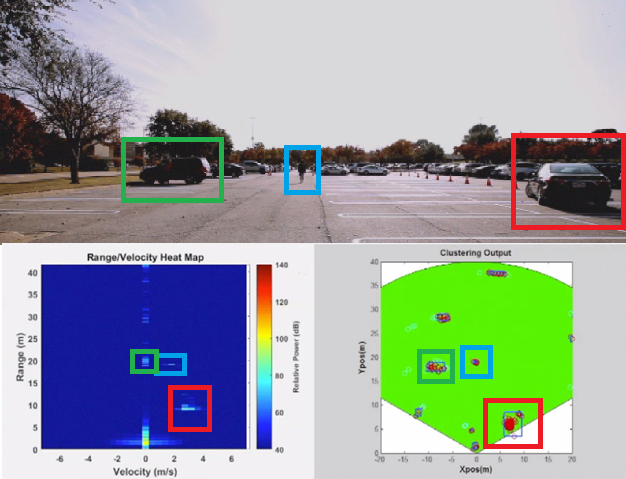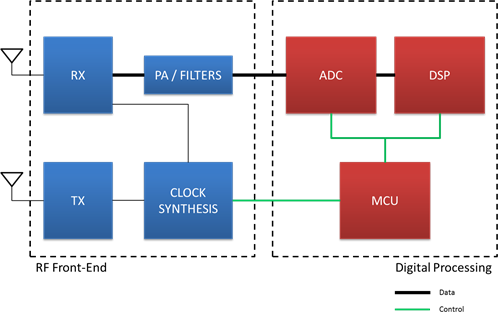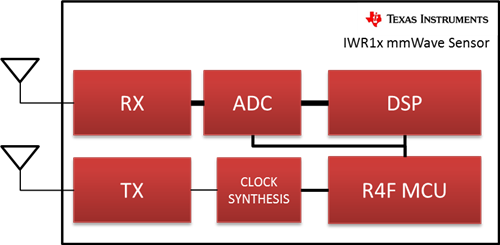SSZTA67 may 2017 IWR1443 , IWR1642 , IWR6843
From position and proximity to level and light, sensing solutions provide a means to sense, digitize and process the world around us. Application-specific problems have given rise to a multitude of different sensing technologies that enable systems to sense conditions with different levels of accuracy and in diverse conditions. With the recent rise of smart infrastructures, Industry 4.0 in factory and building automation products, and newer applications such as autonomous drones, developers are now looking to sensors to help drive new levels of system performance and efficiency.
Millimeter-wave (mmWave) radar technology is uniquely equipped to detect short (5cm) to long (150m+) ranges, and can inherently detect the range, velocity and angle of fast-moving objects (up to 300kph) with high accuracy regardless of ambient lighting, fog, rain or dust. Figure 1 is an example visualization of range, velocity and angle information.
mmWave technology is extremely successful in the automotive industry, but designers are now tackling the challenge of expanding into other markets such as building and factory automation. The issue is that radar systems are traditionally discrete designs, resulting in complex hardware design and software development that create a barrier to entry.
 Figure 1 Range, Velocity and Angle
Information from TI mmWave Sensors in an Example Parking Lot Scene: the Graph
with the Blue Background Is a Range/velocity Heatmap (Where You Can Identify the
Moving/nonmoving Objects and Their Velocities); the Graph with the Green
Background Is a Range/angle Visualization; and Colored Boxes Highlight Moving
and Nonmoving Vehicles and Pedestrians in Both the Scene and These
Graphs
Figure 1 Range, Velocity and Angle
Information from TI mmWave Sensors in an Example Parking Lot Scene: the Graph
with the Blue Background Is a Range/velocity Heatmap (Where You Can Identify the
Moving/nonmoving Objects and Their Velocities); the Graph with the Green
Background Is a Range/angle Visualization; and Colored Boxes Highlight Moving
and Nonmoving Vehicles and Pedestrians in Both the Scene and These
GraphsFigure 2 shows an example discrete mmWave radar system. A radar processing chain requires multiple integrated circuit (IC) components, including a radio-frequency (RF) front end and a digital-processing back end. A discrete radar system requires special care and consideration for how to transmit high-speed radar data on a printed circuit board (PCB), and a central controller such as a microcontroller unit (MCU) must route control signals to all of the discrete components. These systems are especially sensitive to external electromagnetic interference (EMI), making them difficult to design for certain “noisy” systems and more challenging outdoor environments.
Discrete radar systems also introduce challenges for software designers. The configuration and control of a host MCU requires a connection to each of the RF and digital-processing components. Making sure that the system can control each component optimally for changing conditions and application needs requires a great deal of software design and development finesse.
 Figure 2 Example Discrete mmWave Radar
System; Each Colored Block Represents a Separate IC or Set of ICs within the RF
Front End or Digital-processing Back End
Figure 2 Example Discrete mmWave Radar
System; Each Colored Block Represents a Separate IC or Set of ICs within the RF
Front End or Digital-processing Back EndTI’s single-chip IWR1x mmWave sensor portfolio integrates RF mmWave radar technology with powerful ARM® MCU and TI digital signal processing (DSP) as shown in Figure 3, and enables simple single-chip solutions that lower the barrier of entry to mmWave sensing. With TI’s single-chip 10mm-by-10mm IWR1x sensors, you no longer have to deal with complicated high-speed data and communication routes between discrete front-end, analog-to-digital converter and processing devices, nor the additional size, power and bill-of-materials costs associated with supporting them. This level of integration also simplifies the software design process, allowing for dramatically simpler device configuration, monitoring and calibration.
 Figure 3 TI’s IWR1x mmWave Sensors
Integrate All Components Necessary for Single-chip mmWave Sensing to Simplify
Hardware and Software Design.
Figure 3 TI’s IWR1x mmWave Sensors
Integrate All Components Necessary for Single-chip mmWave Sensing to Simplify
Hardware and Software Design.How mmWave Impacts Applications
Fluid-level Sensing is a vital part of factories that store and measure different chemicals. Because the chemicals can be corrosive or toxic, the measurement of volume remaining must occur without direct contact. mmWave sensing offers high-accuracy measurement and strong robustness against environmental conditions, such as dust, fumes or extreme temperatures. The IWR1x RF front end is highly linear; its ultra-wide (4GHz continuous, 5GHz stitched) bandwidth enables extremely accurate sub-millimeter measurements of the fluid level in tanks from 1m to 80m. Design power optimization for 77GHz level transmitter reference design shows how to optimize the IWR1443 for operation in 4-20mA power-constrained systems.
Traffic Monitoring Infrastructure is tasked with improving transportation efficiency by understanding specific information and telemetry about vehicles and pedestrians in order to react to intersection conditions and collect traffic statistics. mmWave sensors enable measurement of both vehicle position and velocity and are capable of detecting objects at rates of speed up to 300kph and distances of 150m and farther. The Traffic Monitoring Object Detection and Tracking Reference Design shows how you can use the IWR1642 sensor not only for vehicle detection, but – by integrating object clustering and tracking algorithms on the on-board C674x DSP – to collect data on how vehicles are moving over time to enable controller systems that can react to dynamic traffic intelligently and in real-time.
Drones have taken off, from enthusiast racing to commercial use in a host of industries such as package delivery and forestry. Drone designer challenges include being able to detect obstacles and provide operator assistance during the most dangerous components of flight in order to safety and increase platform productivity. Drones require high-speed object detection and tracking from distances of 100m to those measured in centimeters, such as when a drone approaches the ground or operates around objects. To increase operating time and payload lift capability, solutions should be small in size and lightweight, since drones are battery-based.
The IWR1443BOOST and IWR1642BOOST evaluation modules are now available to easily evaluate mmWave radar technology and show how to use range, velocity and angle data for a variety of industrial sensing applications. Using the evaluation module with the TI-provided mmWave software development kit (SDK), you can run the out-of-box demo or begin customizing example code for your development within minutes. Also available is example source code that showcases more unusual uses of TI’s high-accuracy mmWave sensing and processing, such as the classification of water versus ground and non contact measurement of heart rate and breathing rate.
Additional Resources
- Learn how mmWave sensor technology works.
- Read more about mmWave sensors in the “Robust Traffic and Intersection Monitoring Using Millimeter Wave Radar” white paper.
- See how mmWave sensors work in drone applications in the white paper, “Drone safety and productivity enabled by mmWave sensors.”
- Download the “Fluid-Level Sensing using 77GHz millimeter wave” white paper.